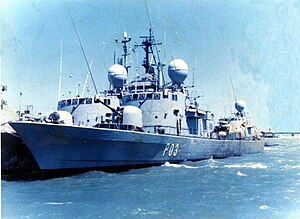Lazaga-class patrol vessel
 Patrol boat Cadarso of the Spanish Navy in 1989. It was transferred to the Colombian Navy in 1997, where it was renamed ARC Jorge Enrique Márquez Durán
| |
| Class overview | |
|---|---|
| Name | Lazaga class |
| Builders | |
| Operators | |
| Built | 1974–1982 |
| In service | 1974–present |
| Planned | 10 |
| Completed | 10 |
| Active | 4 |
| Retired | 6 (1 pending final disposition as of 2011) |
| Scrapped | 5: 4 scrapped, 1 purposefully sunk |
| General characteristics | |
| Type | Patrol vessel |
| Displacement | 303 tonnes |
| Length | 57.4 m (188 ft 4 in) |
| Beam | 7.6 m (24 ft 11 in) |
| Draught | 2.6 m (8 ft 6 in) |
| Installed power | 8,045 hp (5,999 kW) |
| Speed | 31 knots (57 km/h; 36 mph) |
| Range | 3,000 nmi (5,600 km; 3,500 mi) at 15 knots (28 km/h; 17 mph) |
| Complement | 41 |
| Sensors and processing systems |
|
| Armament |
|
The Lazaga class is a series of midsize patrol vessels for coastal and exclusive economic zone patrol, built by the Spanish National Bazán shipyards (now Navantia) for the Spanish Navy and the Royal Moroccan Navy. Two of the Spanish units were later transferred to the Colombian Navy.
Based on the German Type 143 Template:Sclass- vessels, the hull of the first unit was built in Germany and the rest were built in San Fernando, Cádiz, Spain in a similar way to that of the Template:Sclass-, in 1976–1977. A second batch of four units was built in 1980–1982 for the Royal Moroccan Navy, which were slightly different from the initial units in armament and navigational systems, as they included missile capability (Exocet MM-40), although that was later removed.
Service
Spain
Their early retirement from the Spanish Navy prompted an inquiry in the Spanish senate[1] about the reasons for their decommissioning; some of the reasons presented included lack of endurance and lack of a helicopter capability. It seems, however, that the navy was using the ships for roles more complex than those initially designed for. Under its initial German design, the ships were designed for fast attack by the German Navy as fast attack ships using Exocet missiles in the Baltic Sea, allowing for quick return to their bases. In Spain, that was their initial use as well, and they included a modern targeting system Signaal (now Thales) WM-22, similar to that used in the Template:Sclass- (WM-25) and in the Template:Sclass- (WM-28). Budgetary restrictions did not allow that plan to be fully completed and they were not fitted with missile capability in the end, which left them stripped of one of their most important capabilities.
The creation of the Maritime service of the Civil Guard (Template:Lang-es) only sped up their demise in the Spanish Navy, since many small and midsize boats were decommissioned from the navy as some of the coast guard functions were transferred to the new service.
Some of their systems, including the Oto Melara 76 mm/62 cannon, the diesel engines and the surface search radar were dismounted and used as spare parts for the Descubierta-class corvettes which shared those systems.
Morocco
Some of the systems, including the 76 mm/62 Oto Melara cannons, their targeting systems were ceded to the Royal Moroccan Navy.[citation needed] In 2008, two of the Moroccan vessels were upgraded in Cartagena, Spain, for an estimated amount of US$ 10 million[2]
Colombia
Two of these boats were transferred to the Colombian Navy in 1997, where they served until 2009 when they were finally disposed of and sunk as part of the "Pelícano II" training exercises.[3]
Ships of the class
| # | Country | Name | Commissioned | Decommissioned | Notes |
|---|---|---|---|---|---|
| 1 | Lazaga (P-01) [4] | 16 August 1975 | 30 June 1993 | Scrapped; | |
| 2 | Alsedo (P-02) | 1977 | 30 June 1993 | Scrapped | |
| 3 | Cadarso (P-03) [5] | 10 July 1976 | 1993 | Sold to Colombian Navy | |
| ARC Jorge Enrique Márquez Durán | 1997 | 2011 | Retired and awaiting final disposition.[6] | ||
| 4 | Villaamil (P-04) | 1977 | 30 July 1993 | Scrapped | |
| 5 | Bonifaz (P-05) [7] | 11 July 1977 | 30 July 1993 | Scrapped | |
| 6 | Recalde (P-06) | 1977 | 30 July 1993 | Sold to Colombian Navy | |
| ARC Capitán Pablo José de Porto | 1997 | 2009 | Retired and sunk as part of training exercises [3] | ||
| 7 | Commandant Al Khattabi (304) | 30 July 1981 | Active | ||
| 8 | Commandant Boutouba (305) | 11 December 1981 | Active | ||
| 9 | Commandant El Harty (306) | 25 February 1982 | Active | ||
| 10 | Commandant Azouggarh (307) | 2 August 1982 | Active |
References
- ^ "Pregunta sobre la desactivación de patrulleros clase Lazaga" (in Spanish). Senado de España. 17 March 1993. Retrieved 8 May 2011.
- ^ "Navantia ingresará 10 millones por dejar como nuevas dos patrulleras marroquíes" (in Spanish). Spain: La verdad. 18 April 2008. Retrieved 9 May 2011.
- ^ a b "Galería Operación "Pelícano II", 2009" (in Spanish). unffmm.com. 1 June 2009. Retrieved 9 May 2011.
- ^ Los Barcos de Eugenio:Lazaga
- ^ Los Barcos de Eugenio:Cadarso
- ^ Defensa.com, ed. (20 May 2011). "Desactivación e incorporación de patrulleras de costa en Colombia" (in Spanish). Retrieved 23 May 2011.
- ^ Los Barcos de Eugenio:Bonifaz
Bibliography
- Alejandro Anca Alamillo. Buques de la Armada Española del siglo XX (in Spanish). ISBN 978-84-9781-428-7.
